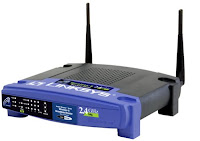The upgrade process itself is fast and simple: download the appropriate Linux-based firmware from this site, then log onto the router itself and flash the new firmware using the 'Update' administration tab... but perhaps I should start at the beginning.
The Router
 A router is a piece of networking hardware that allows computers on a network to communicate with eachother, and with outside networks, by routing packets of data within and between networks. In the typical home use, the router serves as an interface between the Local Area Network (LAN; the computers in your house) and the Wide Area Network (WAN; your Internet Service Provider's hubs that connect to the Internet). The router is the gatekeeper, directing requests and data between the LAN computers and the Internet. A process called Network Address Translation (NAT) allows the router to 'hide' the LAN from the WAN ('IP masquerading'), and the router also acts as a hardware firewall to screen out unauthorized data traffic.
A router is a piece of networking hardware that allows computers on a network to communicate with eachother, and with outside networks, by routing packets of data within and between networks. In the typical home use, the router serves as an interface between the Local Area Network (LAN; the computers in your house) and the Wide Area Network (WAN; your Internet Service Provider's hubs that connect to the Internet). The router is the gatekeeper, directing requests and data between the LAN computers and the Internet. A process called Network Address Translation (NAT) allows the router to 'hide' the LAN from the WAN ('IP masquerading'), and the router also acts as a hardware firewall to screen out unauthorized data traffic.IP Addresses
Traffic is routed on networks by assigning an address to each node in the network. Internet Protocol version 4 ('IPv4') addresses are formatted as follows: 192.168.1.1; this particular representation is known as 'quad-dotted decimal notation'. To connect you to the internet, your ISP assigns you an IP address. Your router then assigns private IP addresses to itself each of the computers on the LAN; the addresses assigned are in the 'private IP address space' (which has been defined by the Internet Engineering Task Force (IETF) ) and only apply internaly on the LAN.
The router therefore has two different addresses: the WAN address assigned by the ISP and applicable to the Internet, and the LAN address assigned by the router itself and applicable within the LAN. Why doesn't the ISP just assign WAN addresses to every computer on your network? There are a finite number of IPv4 addresses, and they are rapidly running out! For the Internet to function, all LANs behind a router are free to use duplicate addresses, but WAN addresses must be unique; by only assigning one WAN address to the router, WAN IPv4 addresses are conserved. This problem eventually must be overcome by changing to a new format that allows a much greater number of IP addresses (IPv6).
LAN, WAN, and MAC
To see information on your network connection on a Windows computer:
- Hit 'Windows-R' to bring up the 'Run' dialog
- Type 'cmd' and hit enter to bring up the command prompt interpreter
- type 'ipconfig /all'
- 'Physical' or 'MAC Address' - unique ID assigned by the manufacturer; AA-BB-CC-DD-EE-FF
- 'IPv4 Address' - your computer's LAN IP address
- 'Default Gateway' - the LAN IP address of your Internet Gateway (your router)
When you're surfing the internet, your computer is sending requests for Internet information to the LAN IP of your router; the router uses NAT to hide the LAN IP address of your computer, and sends the request off into the Internet superstructure (a future article!). The Internet replies to the WAN IP of the router, which then forwards the reply to the LAN IP of the requesting computer. Fortunately, not too complicated!
Now that you know a little about LAN, WAN, and MAC addresses, you're ready to access and configure your router! Stay tuned for Part II.




Believe it or not, it is the type of information I’ve long been trying to find. It matches to my requirements a lot. Thank you for writing this information. 192.168
ReplyDelete